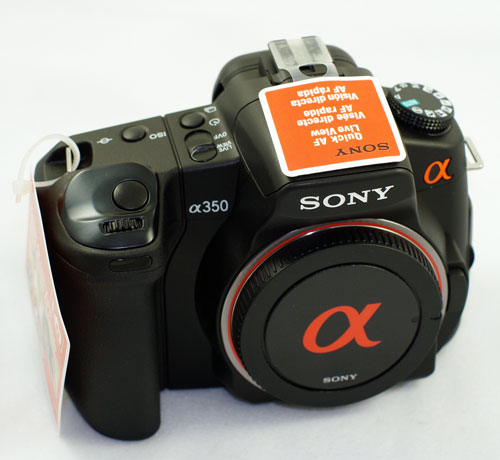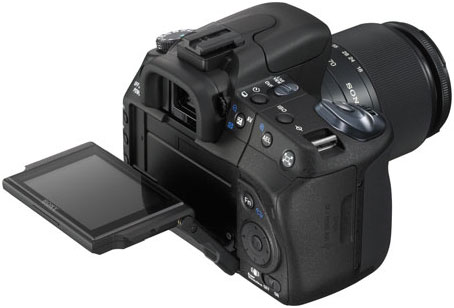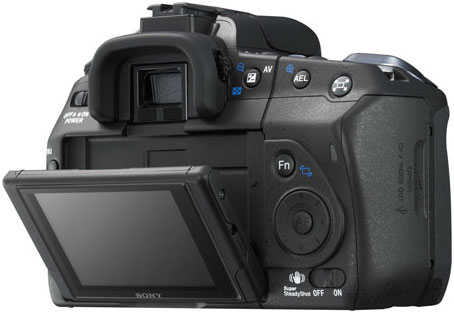Sony A350: Full-Time Live View at 14.2MP
by Wesley Fink on April 3, 2008 3:00 AM EST- Posted in
- Digital Camera
Features and Handling
Sony is used to playing in the large volume retail space where every trick used to gain visibility can result in higher sales.

This is very clear in the packaging theme for Sony DSLR cameras and accessories. No one will miss the bright orange and white (or bright orange and silver) that makes the Sony packages stand out.

The A350 body is on the small side, like the other Sony entry DSLR models, without the extreme smallness that seems to some a problem with the Canon XTi or Nikon D60/D40x. The new Canon XSi is a bit larger than the previous model to address size complaints and accommodate a 3.0" LCD. The Sony A350 is both a little wider (5.25" vs. 5.1") and taller (4.0" vs. 3.8") than the upsized XSi. Minolta pioneered body-integral image stabilization, and the evolved Sony Super Steady Shot is a feature on every Sony DSLR, along with auto sensor cleaning.
The top deck contains a single dial to adjust mode (full-auto, program, shutter-priority, and aperture-priority) and a wide selection of special scene programs such as portrait, sports, night, etc. On the opposite side of the viewfinder hump you will find a mechanical (no power required) Live View/OVF (Optical Viewfinder) switch, timer/drive mode button, and ISO button. The shutter release and shift/adjust dial are on top of the comfortable handgrip.

9-point auto-focus is featured on the A350. The layout and pattern is the same as the A200, A300, and earlier A100 suggesting it is the same AF module. The burst AF speeds on all models also support the conclusion that this is likely the same venerable AF module used in previous Minolta and Sony digital SLRs. Sony claims faster AF in the newest models, and that is likely the result of faster data processing in the supporting data processing modules in the DSLR. The prosumer A700 uses an updated and faster 11-point AF system. The A350 AF system is very competitive in its class and a big step up from the Olympus 510/410/420 and Nikon D60/D40x 3-point AF modules.


While the A350 is a bit larger than the Canon XSi, the LCD is 2.7" instead of the 3.0" LCD featured on the XSi. However, it is the only LCD in its class that is articulated, allowing an upward tilt as far as perpendicular for low-level shots and a down tilt to allow holding the camera above your head for crowd shots. These kinds of shooting situations require a contortionist on the usual DSLR and they are a great benefit for the capable and fast Sony Quick AF Live View. The LCD brightness is adjustable up and down, but it was still a challenge to read info on the LCD in bright sunlight. Perhaps some aftermarket LCD hood will improve LCD viewing.

The rear finds the on-off switch to the left of the viewfinder, which is typical of all the current Sony models. To the right of the viewfinder are the metering pattern/exposure compensation button, AEL (exposure lock)/zoom button, and the unique auto teleconverter. The teleconverter switch just takes advantage of the high-resolution sensor to give you instant 1.4x and 2x crops of the regular image. It does not add or interpolate pixels.
The main part of the a350's back is dominated by the 2.7" tilt screen, and the expected MENU, DISPlay, Delete (Trash Can), and Playback buttons to the left of the screen. To the right is the extremely useful Fn (function) button, which brings up the most commonly used adjustments to allow quick adjustments without searching through menus. The up/down/select multi-controller is used to navigate menus and the screen and a Super Steady Shot on/off switch complete the rear controls.
The sensors at the bottom of the viewfinder are the trademark Minolta "auto-on" when you bring the viewfinder toward your face in OVF mode. There is also a small knurled wheel to adjust viewfinder focus to match your eyesight. This former high-end feature is now making its way into almost all of today's DSLR cameras.
Handling
The A350 is an entry-level camera despite some high-end features like the 14.2MP sensor. As such, it is designed to be easy to use. Ours came out of the package setup at the factory for Live View mode with Super Steady Shot on. In general, Sony made the controls very easy to use and figure out. Sony tells us one complaint from buyers moving from point-and-shoot digital cameras to a digital SLR is that they are often overwhelmed by the controls of the DSLR. Point-and-Shoot users will find the A350 easy to use and familiar right out of the box.
Another editor at AnandTech ordered the A350 from SonyStyle as soon as he saw the specifications in our PMA reporting. He received his A350 last week and commented that the controls on the A350 were extremely easy to figure out and use. He said after 15 minutes he felt like he could figure out most everything on the camera and he was ready to "shoot like a Pro" with the A350. If other new users also find this kind of "instant comfort" with the A350, it will become a big seller.










113 Comments
View All Comments
GoSharks - Thursday, April 3, 2008 - link
However, in a typical situation, I doubt anybody is using ISO100 in combination with a 2 second exposure. I do not believe this is a real-world condition.Wesley Fink - Thursday, April 3, 2008 - link
Agreed. That is another obvious concern. I am very happy to hear suggestiosn on what any of you feel are the best "real-world" test conditions. Nothing is set in stone at this point.Justin Case - Thursday, April 3, 2008 - link
It's beyond me why AT bothers with this. AT's photography articles are little more than rephrased sales brochures and spec sheets from the manufacturers. Most don't even have photos taken with the cameras (why do I need 7 or 8 photos of the camera itself? I can get that at the manufacturer's site, which is where you downloaded them from anyway), and the testing procedures are inconsistent and amateurish to say the least.There are dozens of photography sites out there that have tested these and a lot of other models, using relevant methods, and with reviews written by people with years of experience with all sorts of different cameras and all sorts of situations (film, digital, studio, wildlife, holiday snapshots, etc). Heck, there are forum posts at DPReview with more information and better test shots than all AT "photography" (meaning camera spec sheet) articles put together.
If you're not going to at least attempt to offer something that all those sites aren't offering, why bother? If you can't offer expert opinion, at least include a lot of samples, so people can get an idea of what each camera can deliver in different situations. As it is, these reviews seem like something out of a teenager's blog, put together in one afternoon, and reflect negatively on Anandtech's image of professionalism.
I guess it's all about filling the space between the ads...
Deadtrees - Thursday, April 3, 2008 - link
I'm amazed how the comparsions are poorly done.The more look at it, the more I find problems.
1.K20D - Saturation:Normal, Sharpness:High, Contrast:Hard
A100 - Saturation:Normal, Sharpness:Normal, Contrast:Normal
I hope you know those changing those parameters can impact image qualities. Let's see what's possible: I can turn down sharpness/contrast/saturation of camera A and turn up those values on camera B and come out with a conclusion that camera A produces blurry, faded colored, and low noise images with better dynamic range/tonal reponse, and than camera B.
2. K10D: 1.5 sec, 5D: 1 sec. (of exposure time)
Even after numbrous posts about setting the same exposure, you re-shot images with different expososure settings. As I mentined earlier, 5D and some other cameras has different ISO standards (ISO 100 being 125, 3200 being 4000) and along with different exposure mechanism, this could've resulted the difference as you used AV mode. However, you should've mentioned it if it's the case or just set the same manual exposure settings.
Also, what kind of long shutter noise reduction setup did you have? Without mentioning it and understanding it, the reivew of the samles are pointless.
Wesley Fink - Thursday, April 3, 2008 - link
Actually I reviewed the A350 and not the Sony A100, but I understand it was an honest mistake. I wish you could provide me the same courtesy.Frankly you would be amazed at the level of integrity at AnandTech in terms of presenting accurate data in as unbiased a manner as possible. Our ad agency is completely separate from AT and we don't even see data on who the biggest advertisers are. That is by design.
We have stated many times that we have no desire to mirror the large established photo sites. I have read and enjoyed them for years, but they are not everyone's cup of tea. Most of our readers are intimidated with the depth of info at the dedicated photo sites and they have asked us to provide reliable information at a lower level that is more accessible and requires less specialized knowledge. That is our intention.
I do understand the impact of noise reduction algorithms on image detail. I also understand the potential impact of adjustments in sharpness and saturation. I will use that knowledge to try to test DSLRs as fairly as possible, but delving deeply into those variables will not be a standard part of our reviews in the near future. Perhaps we will do more standard testing of those variables down the road.
Deadtrees - Thursday, April 3, 2008 - link
There're many things you need to know before you can be, at least, a fair reviewer. Reading your reviews and replies, I doubt if you even have a somwhat basic knowldges. When I said that certain cameras have different ISO standards, you had no idea what I was talking about. How can you make conclusions about any cameras noise level without knowing this?Not only that, what kind of reviewer tests image resolution/noise level using different aperture values?
On the other hand, do you know that noise reduction algorithm differs from brands to other brands? What's even more confusing is that even cameras from a same brand have different noise reduction system. For instance, noise reduction on Nikon D200 will kick in After ISO 400 even if you turn it off in the menu and it's not the same way in other Nikon cameras.
Without knowing this, you might just think that you tested cameras equally as you've had the same setup but it's not.
Before doing the test and writing up the review, did you care to know the noise processing mechnisms of those cameras? I doubt so.
Look at images from A350, in order to maintain low noise, it utilizes way too much noise reduction(more like smearing) that results great loss of deatils. Hell, it even looks like water painting. Sure, the noise is low but with the cost of loss details.
Given that, your saying "The good news about the sensor is that output is very clean and noise remains low up to ISO 1600" is quite thoughtless.
Again, you're the reviewer of Anandtech and that means something. It means you shouldn't write a review that is more like a blog posting of somebody on the internet.
I know it's a computer hardware site but the respect Anandtech has achived should reaim even in camera reviews. Readers shouldn't be the victim of amateurish reivews.
Heidfirst - Thursday, April 3, 2008 - link
"Look at images from A350, in order to maintain low noise, it utilizes way too much noise reduction(more like smearing) that results great loss of deatils. Hell, it even looks like water painting. Sure, the noise is low but with the cost of loss details."Experience with the A700 says that this can be due to the processing software used & afaik the A350 uses the same file format as the A700 - e.g. ACR does a poor job (in the same way that it did a poor job with the Oly E-3 until Adobe issued a patch for it) whereas e.g. Bibble handles it better.
So, at the end of the day we are not only comparing the individual sensor output but the camera's processing (& as mentioned there may there be also be differences between camera settings - e.g. what one calls a high setting may not be the same as that on another), the lens quality & how the processing software used handles the individual output.
That's quite a lot of variables to get a truly level playing field fora comparison.
Wesley Fink - Thursday, April 3, 2008 - link
Of course I knew what you were talking about when you mentioned ISO variance among cameras at the same ISO setting. I am always willing to listen to constructive criticism, but I have little patience with comments that are self-serving grandiosity. I have made a living as a PRO photographer - have you?You should also mention that almost every NEW camera that has been tested for ISO speed variation is today largely correct in the reported ISO. I am aware of the issue but its importance today is low and not that signigficant to our intended audience. The biggest offender was Canon, and their newer cameras are now testing correct as well. I doubt, however, that your real goal was to share information. It sounds from your tone that your goal was to belittle rather than educate or provide constructive criticism..
I don't know everything, but you haven't mentioned one thing that I don't understand, so please get off your soap box. We have stated many times that we have no desire to mirror dpreview. They are a terrific site for photo information and in-depth reviews. I have read and enjoyed them for years, but they are not everyone's cup of tea. Most of our readers are intimidated with the info at the dedicated old school photo sites and they have asked us to provide reliable information at a lower level. That is our intention.
I also briefly discussed the impact of noise reduction in the review and I am keenly aware of the ongoing discussion about the impact of noise reduction schemes on image detail. I also am aware the K10D is best RAW and the noise reduction algorithm is poor, but that is from my experience with the camera. I might add that the K20D behaves differently - from experience - but you don't know that yet because while I have done a first hands-on look at the K20D, the major photo sites haven't posted any real reviews of the K20D yet.
Yes, we made errors in this first real DSLR review, but we have worked diligently to correct them. I have just posted the crops and full images for the reshoot with the Sony A350, so all images are now consistent in shooting conditions and they can be fairly compared. I think you will find what I concluded in my initial review can now be more clearly seen in the crops and full images.
We are obviously too basic for your tastes and I wouldn't want your head to hurt with the drivel you see here. By all means continue to get the information you need from the current established photo sites. We are aiming to provide reliable information to a wider cross-section of users and we will not likely satisfy the level of detail you seek.
cputeq - Wednesday, April 2, 2008 - link
I just wanted to give you guys props for trying to "make things right" ;)We're all guilty of missteps sometimes (hell, I'm King Screwup..just witness my home improvement attempts!), so it's good to see you guys take this in stride and do what it takes to correct any apparent errors while also trying to improve the review.
So, I hope you guys don't get too disgruntled with some of the forum posts -- people type stupid crap on the web every day ;)
I look forward to seeing the reshoot -- and yeah, btw, the proper crops are now showing up for me on page 6. All I have to say is "wow". The ISO 400+ crops are horrible for the Sony :( I'll be interested in knowing the culprit, as I couldn't imagine a camera of this caliber looking that noisy at 400.
While a smallish printout may not count, so people (like myself) are cursed and look for the smallest stupid details in pictures!
Thanks again for all you guys do!
Wesley Fink - Wednesday, April 2, 2008 - link
Your comments are sincerely appreciated. I suspect the f4 reshoot with fixed f4 aperture will fix the apparent Sony issues. THe first crops, with the Sony at f2 and the Pentax and Canon at 1.4, made the Sony look like the better camera, which is not the case. In the reshoots the K20D and 5D look more as you would expect. We will post the new A350 crops and images late tomorrow assuming the camera is received as promised.